Day 4: Surprise from the skies
20 February 2007
12:00 AM
Torres del Paine — Day 4
February 3, 2007
The rain was sometimes a blessing. This morning, for example, the rain gave us an excuse to sleep late. We started our day so late, in fact, that we skipped breakfast and went straight to the peanut butter and jelly sandwiches.
We had slept at Campamento Italiano, which lay at the base of the middle spoke of the W trail. The day’s plan was to hike up that center spoke and back to the base where we would spend a second night at Italiano. That meant no packs. As we set off wearing our cumbersome raingear, I felt light as a feather. I bounded up the mountain even though my legs were sore. They rejoiced at having to carry a mere 160 pounds instead of over 200. My shoes suddenly felt much more comfortable.
The rain came and went throughout the afternoon. Low-hanging clouds and haze made the day dreary. Everywhere else we looked we saw nice weather, which made our particular patch of gray skies seem grayer still. The sun shone over Lake Nordenskjold at our backs. From certain high points, I could see the Cuernos in clear, blue skies to our right. Slightly north of the Cuernos I saw, much to my surprise, the backside of the Torres. I thought I had bid them farewell the day before. It was an unexpected reunion, though one I should have been able to anticipate if I had taken any time at all to study the map.
Our immediate surroundings were formidable. Swathes of ice covered the Great Paine on our left-hand side. Some ice patches had a cool, blue color; others were a dirty gray. At the edges, the ice melted into a multitude of waterfalls that fed the valley’s central, raging river. We could faintly make out the Paine’s peak through the fog. Much of our time was not spent in clearings that afforded a view of the Paine, though. We twisted in and out of dark forests thickly populated with trees. I heard many people on the trail say that the park evoked Tolkien’s Middle Earth. If that were the case, then we were walking in Mordor, the land of shadows.
When we saw or heard the main river I was impressed by the sheer quantity and force of the melted water. I suppose I had thought of melting as a gradual, gentle force, not the violent, powerful one I saw. There was certainly no shortage of water. The rain notwithstanding, this valley was a wet place. No sooner had we crossed one stream on its way to join the river than we arrived at another.
Given the number of streams we crossed, I should mention that Torres del Paine is a backpacker’s paradise. I say this not just because of the scenery, nor because of the occasional opportunity for a hot shower, but because many typical backpacker concerns don’t exist there. Water, for example, is potable everywhere. You can fill your water bottle directly from the stream and drink it untreated. The park rangers endorse the practice, and everyone does it except for one hiker we met who told us he used iodine drops because the idea of untreated water scared the bejeezus out of him. The water was good H2O. I thought I could make a pretty penny if I could bottle the stuff in the States (“Made from the ice of pure Patagonian glaciers”). All the berries in the park are safe to eat as well—as we hiked I plucked handfuls of red ones for a tasty trail snack. There are no bears, which means no bear-proofing the campsite, and no snakes either. I don’t think snakes are a typical backpacker concern, but I think they should be. The pumas in the park make themselves scarce. You’re considered lucky if you catch a glimpse of one. To my disappointment, I was not. I walked the trails trying to lure them out by saying, “Looks like there aren’t any pumas around these parts. Definitely not going to see one of them here today.” Amanda was not amused.
Shortly after we passed Campamento Britanico, we got a little meteorological surprise. In our few days in the park, I had adjusted to the rapid and by now predictably unpredictable weather changes, but this was something unexpectedly unexpected. Amanda confirmed my observation: snow. It wasn’t a blizzard by any means, but there were white flakes drifting gently through the air and landing on our clothes. Yesterday we had been hot in shorts and T-shirts; today it was snowing.
After a couple hours of up and down (but on the whole, up), our energy was waning. I was growing somewhat frustrated with the trail’s attitude. Why would it let me walk down a steep downhill if it goes right back uphill a few yards later? I asked myself this question several times. By the time we were fifteen minutes past Britanico, our energy reserves were just about empty. From our current position a number of colorfully-named peaks sat in the distance: the Cathedral, the Shark’s Fin, the Castle, the Twin Hills, and the White Throne. We couldn’t see jack. The sum of the low visibility, the cold, and our fatigue lead to our executive decision to turn back about an hour short of our goal. Other hikers told us the view at the end of the trail was impressive, but there wasn’t much point in hiking to see the unseeable.
As we descended I had more time to appreciate the views. The weather cleared, and we could see the icy face of the Great Paine more clearly. There was so much ice that it made you cold just to look at it. A certain variety of tree also caught my eye. At times its branches were nearly perpendicular to the trunk. Leaves covered the branches sparsely, arranged like a hand held upwards, palm open to the heavens. Since we were distracted by the scenery, it took us hardly any time to make it back to camp.
Then it was time to eat again. Amanda had more experience camping and backpacking, so she put herself in charge of our food and cooking. This was good news to me because I just recently learned how to keep myself satisfied in the kitchen, and the new constraints of trail cooking frightened me. I was somewhat alarmed, however, when she showed up in Chile reading Alive, the real-life story of the Uruguayan rugby team’s plane crash in the Andes where the survivors had to resort to cannibalism to stay alive. Great, I thought. My travel companion is planning our meals and reading a book on cannibalism. This looks good. My main consolation was that I would be gamey eating.
I needn’t have worried. Besides the cannibalism book, she arrived with a half-dozen giant zip-lock bags. Each contained the measured ingredients for a meal, complete with a photocopied recipe card taken from the National Outdoor Leadership School (NOLS) culinary bible, Cooking. This wasn’t just any trail food, either. It was better food than I ate at home. One night was whole-wheat pasta with a cheese sauce. The next was pad thai noodles with a spicy peanut butter sauce. This evening we ate a potato and cheese soup— seasoned with garlic powder and dried onions—and biscuits. I kid you not. We cooked everything in our single pot, which was the size of a cantaloupe, over our gas flame. For the biscuits we fried both sides lightly in butter and then simulated baking by cooking them in the closed pot over low heat. Also at Amanda’s suggestion we bought two half-liter boxes of wine (what’s two extra pounds?), which are high class when compared with U.S. boxed wine offerings. After our long day of hiking, we had a glass of wine with dinner. I ate like a king on the trail. Other backpackers at our site were likewise impressed. An Australian took one look at our outdoor kitchen and his mouth dropped open, as he squirted tomato sauce from a bag onto the pasta he was eating directly from his pot.
The piece de resistance was the no-bake cookies that Amanda prepared. We boiled water and mixed in powdered milk, butter, and brown sugar, followed by cocoa powder and oatmeal. Then we formed balls from the gooey mess and let them cool. The cookies were a campsite hit. An Englishman said, “You have no idea how good this tastes. I’ve been on the trail for ten days and haven’t had anything like this.” Another man asked Amanda for the recipe. Later in the week we ran into two Irish women from that night who, upon seeing Amanda, exclaimed, “The cookie lady!” I was doubly happy because the cookie ingredients had been in my pack. Now in addition to the tasty treat, I had less to carry on our last day of hiking.
Be sure to return tomorrow for the sights—including one we shouldn’t have seen—during our last day on the trail


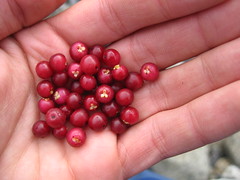
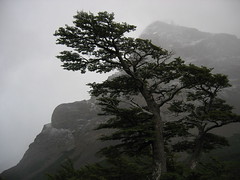
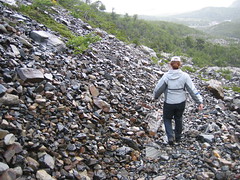
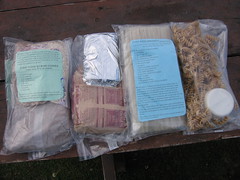
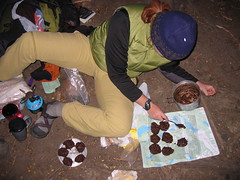

Comments